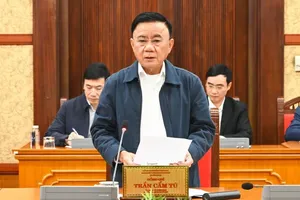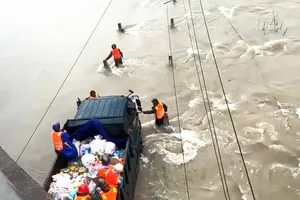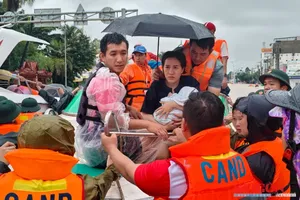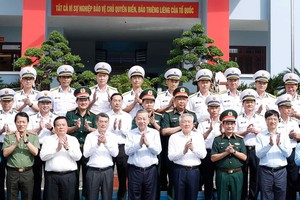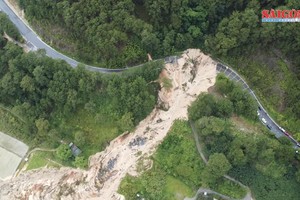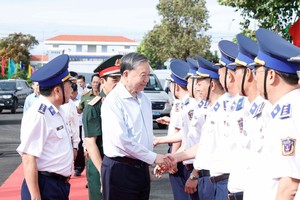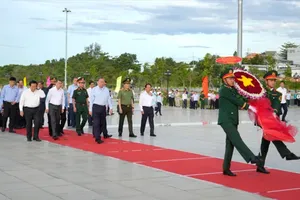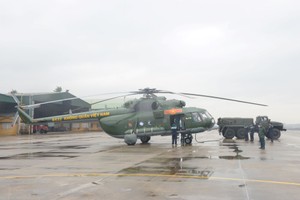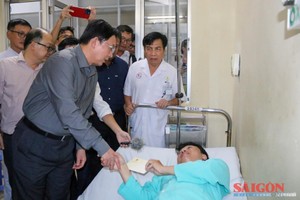
Paralyzing transport due to rising floodwaters
From November 19-20, severe flooding ravaged Khanh Hoa Province, submerging 162 points across 54 communes. In areas like Nha Trang and Dien Khanh, water reached roof levels, forcing desperate residents to retreat to attics or break through roofs to escape. In Tay Khanh Vinh Commune, 1,000 people sheltering in a church faced food shortages, eventually climbing mountains in the dark to survive.
By November 20, floodwaters paralyzed traffic across western and southern districts. Responding to provincial Party Secretary Nghiem Xuan Thanh’s order for “maximum mobilization,” the Naval Region 4 Command dispatched nearly 400 officers and 21 vehicles. They coordinated with local forces to execute urgent evacuations and protect vulnerable groups amidst the rising waters.
In Lam Dong Province, Military Region 7 immediately deployed 100 officers and 20 lifeboats, placing 1,000 personnel on standby for rescue. Simultaneously, a massive landslide at Mimosa Pass completely severed National Highway 20. By the afternoon of November 20, landslides had cut off four of the six mountain passes leading into Da Lat area. Consequently, authorities banned trucks over 3.5 tonnes from the remaining two routes of Ta Nung Pass and Sacom Pass to ensure safety.
By the afternoon of November 20, deep floods submerged eastern Dak Lak Province, prompting the deployment of thousands of military and police personnel.
Colonel Nie Ta confirmed canoes had reached isolated residents in the communes of Song Cau, Tuy An Dong, Tuy An Tay, and Dong Xuan, while the military distributed 1 ton of dry provisions. Simultaneously, police forces launched rapid rescue operations in Hoa Thinh and Hoa My Communes, utilizing high-capacity canoes to deliver essential supplies.

Relief, reinforcement for flooded areas
On November 20, as rain subsided in eastern Gia Lai Province, thousands of soldiers and police seized the respite to supply essentials via canoe and relief convoys to heavily flooded zones like Quy Nhon Dong, Quy Nhon Bac, and Tuy Phuoc.
In western communes like Ia Pa and Ia Hiao, floodwaters receded, leaving homes dry but access roads severed. Local authorities mobilized forces to clear heavy mud and debris. In Ia Hiao, where 700 homes dried out, residents are returning livestock and cleaning properties.
Commune Party Secretary Pham Van Phuong stated that schools are being sanitized to prevent disease outbreaks and resume classes. Despite the progress, numerous areas remain isolated due to damaged infrastructure, necessitating continued recovery efforts.
In Po To and Ia Rsai communes, receding waters have ended the isolation of over 880 households. However, Mo Nang 2 Village (Ia Pa Commune), with 341 households, remains cut off. In Nu Hamlet (Uar Commune), hundreds of residents are still sheltering in schools as their homes remain flooded.
Total mobilization for evacuation
In the evening of November 20, Deputy Prime Minister Ho Quoc Dung directed flood recovery efforts, ordering authorities to mobilize total force to evacuate isolated residents, particularly in Dak Lak and Khanh Hoa provinces. He mandated police and military units use their headquarters as shelters and provide food.
Furthermore, he tasked related ministries of National Defense, Public Security, Science and Technology to deploy equipment, urgently restore communications, and repair traffic routes in Lam Dong Province, emphasizing that no one should remain in critical danger.
At the “flood epicenter” of Luat Le (Tuy Phuoc Commune), heavy rain and a surging Con River breached a dike section, unleashing massive water pressure that submerged numerous residential areas.
Vo Thi Luoi, a resident of Luat Le Village recounted: “The flood rose so fast, it swallowed our entire fortune. Over 100 pigs were swept away; our herd of 6 cows is gone too. My husband and I just waited for rescue. Thanks to the soldiers, we were brought out safely, otherwise, I don’t know what would have happened.”
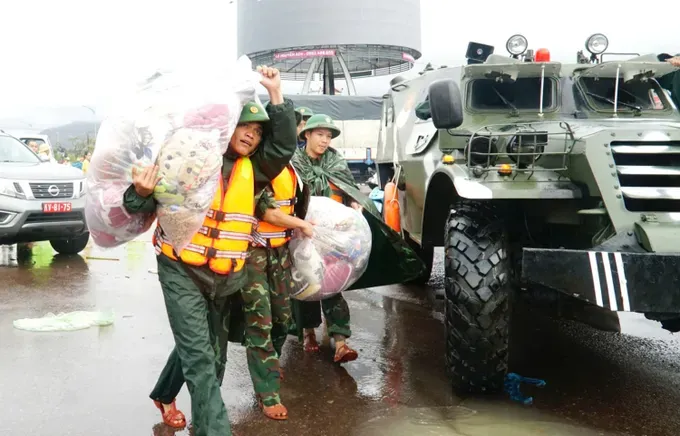
Colonel Nguyen Xuan Son, Deputy Political Commissar of the Gia Lai Military Command, stated: “Heavy rain and fast currents made evacuation very difficult; soldiers had to use ropes to secure life buoys just to reach people.
Currently, Military Region 5 and Army Corps 34 forces continue to sweep deep flood zones, prioritizing the elderly, children, and women, and providing essentials. In Luat Le Village alone, 150 officers and soldiers are holding their positions to provide relief and fix damage as the flood recedes.”
In Quy Nhon Bac Ward, Chairman Nguyen Thai Dien reported that four neighborhoods remain submerged under 2-3 meters of water. While full damage assessment is impossible, preliminary statistics indicate huge property losses; casualties are still being tallied.
“The water is slowly receding,” he said. “Police, military, and local forces are struggling to access deep zones to support the people. Military Region 5 forces are deploying personnel, vehicles, and food supplies to these heavily flooded areas.”
Vice Chairman Nguyen Tuan Thanh of the Gia Lai Provincial People’s Committee reported that the flood has killed 3 people and inundated or isolated 19,200 households, with 7,500 under 2-3 meters of water. Damage is estimated at over VND1 trillion (US$39.3 million).
The province mobilized 20,000 personnel for rescue and recovery. Immediately after the flood, the province provided emergency support to about 5,000 poor and near-poor households, giving each VND2 million/3 months (totaling VND6 million/household). The province has petitioned the Central Government for 2,000 tons of rice and VND60 million ($2,200) support for each household with a collapsed home.

